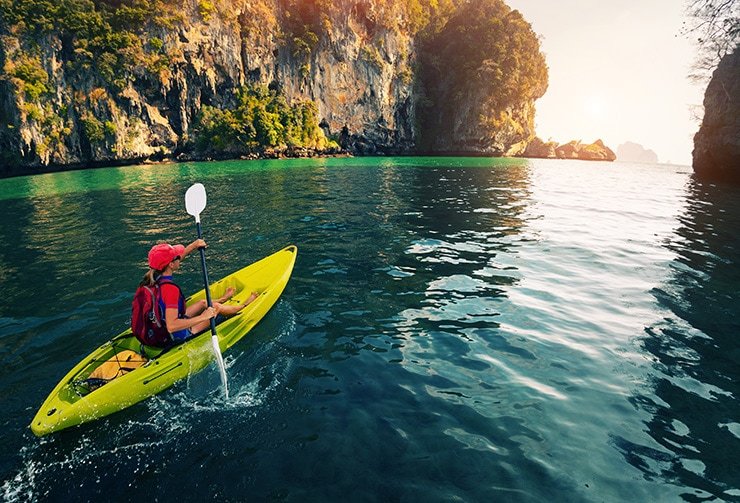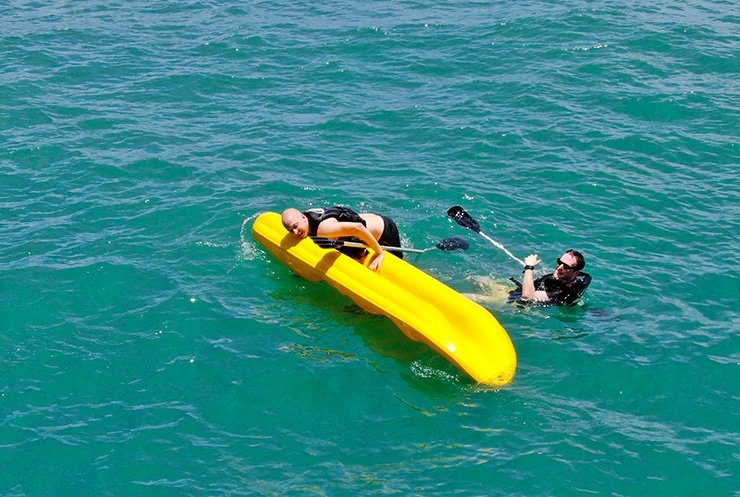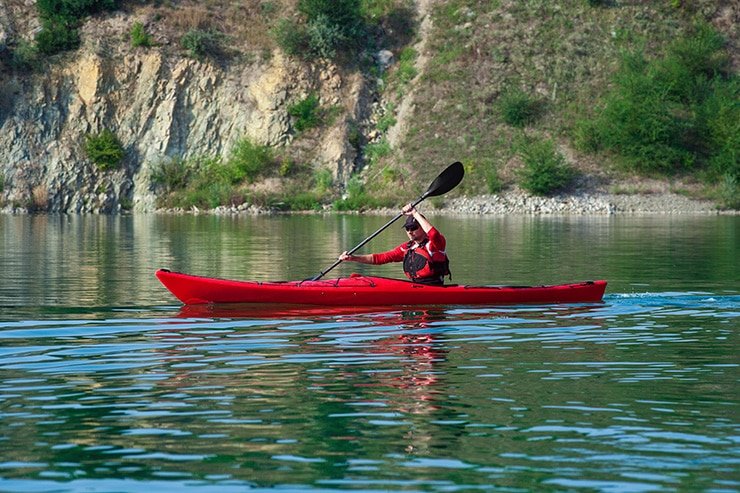Solo kayaking can be a wonderfully fulfilling experience for almost anyone. However, before you begin, there are some skills to learn and knowledge to gain.
While you shouldn’t be discouraged about practicing or spending time alone with your kayak, you will want to understand some essential things first.
In this guide, we’re going to cover everything you need to know.
Key Takeaways
- Solo kayaking can be a rewarding and enjoyable hobby, but it requires some skills and knowledge to do it safely.
- Before your solo kayaking trip, check your safety equipment and weather conditions, and create an emergency plan.
- Try to pick a familiar location, practice your launching and landing skills, and paddle at a comfortable pace.
- Solo kayakers should learn how to navigate, plan, and recover from capsizing with the help of mentors or groups before going solo.
- Kayaking solo can help kayakers develop their confidence, self-reliance, and introspection.
What You Need To Know Before Solo Kayaking
While it’s common to hear people advise against kayaking alone, the fact is, it’s a very popular way to enjoy your hobby. Solo kayakers often have an entirely different experience; that’s more about introspection than showing off.
Before you attempt to go it alone, there are some essential things to account for first.
Is It Safe To Go Kayaking Alone
Sometimes, kayaking alone is said to be risky. This is only partially true and depends entirely upon the location and conditions you’ll be kayaking in and how experienced you are.
The most important thing to know is that anyone can solo kayak as long as they put the effort in, but you’ll have to commit to learning the basics and considering a few things first.
ALSO READ: What Are the Risks of Kayaking?
How Young Can You Be To Go Kayaking Alone?
You have to be 18 to rent a single-person kayak. If you’re below the age of 18, then you need to be supervised by a legal guardian or parent. If you own a kayak, you’re subject to state boating laws.
There are no overarching federal laws that govern age restrictions – they depend on individual state laws.
Every state has its boating laws and you can usually find these via a website or by contacting your local government administration.
Beginners Should Not Attempt Solo Kayaking
Most novice kayakers are instructed to not paddle alone – for good reason! Paddling solo when you’re not experienced enough is dangerous as there is a risk of getting yourself into a situation where you can’t recover properly.
When you’re learning, you must be supervised by a mentor or a group of more experienced kayakers. Some states may even require that the person teaching the group has completed a boating education course of some kind.
Getting confident in your skills before you become a die-hard solo paddler is super important. Learning to kayak solo is also about learning to be self-sufficient; while some people adore the challenge of going it alone, for others losing the safety net of a group can actively derail their progress.

How To Kayak Alone – 7 Tips for Solo Kayaking
If you’re a solo kayaker, there are some things to keep in mind when going it alone. Read these safety tips to better prepare for your next solo paddle.
1: Check Your Safety Equipment
By far the most important thing is to check your safety equipment. The following is all the safety equipment you’re going to need before setting out on solo trips:
- A personal flotation device – a comfortable life jacket is crucial for safe kayaking. While not everyone finds these comfortable, they are the most important thing to have and a good kayak-specific life jacket will not restrict your movements while also being comfortable.
- A waterproof bag – this acts as a storage container for anything you might need.
- A fully charged mobile phone – while some may do solo paddling far enough that they don’t get a signal, it’s still an incredibly useful piece of technology to have. Your phone can also give you up-to-date information about the weather.
- Signaling kit – This usually includes a whistle and a flashlight, although in some cases it can even include a flare gun! This depends on how far out you plan to kayak – at the very least you’ll want a flashlight.
- It’s also a good idea to bring some snacks and some water.
- A VHF radio – this is a marine radio that’s ideal for communications if you plan to go sea kayaking out of the service range for a mobile phone.
- A spare paddle – this is another piece of equipment that you might only want to include if you plan to kayak far away from the shore.
Doing a check of your safety equipment is the most important habit you can get into if you plan to get into kayaking solo. Where you’re going and what the conditions are like will determine what equipment you need. A multi-day expedition is going to need more kit than a short, shallow water trip.
ALSO READ: Kayak Safety Essentials: The Three Golden Rules of Kayaking

2: Choose an Appropriate Location
If this is your first ever solo kayaking trip then another thing to prioritize is choosing a good location. Decide on an area where you know the waterways well, and you know how bad the conditions can get.
If you’ve yet to learn an area particularly well, get a mentor or a bunch of experienced friends to help you learn the area. . While it’s common for experienced kayakers to explore new areas (and for many, that’s one of the things they love about kayaking) if you’re still a novice then you should stick to a paddling location that you know well.
Check out landmarks and get familiar with the overall distance you’d have to cover. Understanding good solo launching, you can set off from will help you feel more confident and give you the mental space to focus more on your movements.
3: Check the Weather
Once you’ve decided on a good location, it’s time to start checking the weather. While this may seem obvious, sudden weather changes can dramatically affect the behavior of water.
Quick changes can turn a calm and peaceful trip into a battle of endurance that you might not be prepared for. If this is your first trip, it’s a good idea to get into the habit of checking the overall weather pattern.
There are tons of weather apps that will give you plenty of valuable data and inform you og you the likelihood of any abrupt weather changes so you can adjust your plans accordingly. While some rough water is ok – too much can be overwhelming on your first few trips.
4: Start With Short Trips
Short trips will allow you to develop some important skills, such as solo launches and landing skills, which are important to master. Sometimes people forget that kayaks can be heavy – getting comfortable with solo launching and landings gets you used to the weight of your kayak.
Being able to handle the weight of your kayak also prevents unnecessary crashes and potential injuries while at the same time improving your skills and developing your confidence. Do whatever you have to do to get good at launches and landings – there are all kinds of resources, courses, or groups you can join.

5: Have an Emergency Plan in Place
While it’s unlikely that things will go badly wrong, it’s important to have an emergency plan in place should the unexpected happen. It may seem obvious, but tell your friends and family where you are and how long you’ll be gone.
Have your safety kit and determine what the risks are. If you’re sea kayaking and you’re taken off course, determine how you can contact the coast guard for assistance. If you plan to do a more extended trip, bring a little more than you need, just in case. Little considerations like this can help you out in a pinch.
If you’re solo kayaking then it means taking matters into your own hands; you have no one else to depend on but yourself. So, if you’re not confident in your navigation skills then spending some time brushing up will pay off massively.
6: Practice Solo Paddling
One of the biggest hurdles to successful solo kayaking is proper paddling technique. Sometimes this is the thing that trips people up the most, especially if they’re used to group trips.
This is where taking short trips can benefit you, because you’ll quickly learn what your limitations and rhythm are by taking frequent shorter trips. Paddling too strongly can lead to a loss of good technique and tire you out more quickly.
Understanding just what your ideal pace is will go wonders towards developing your confidence – and the best way to do this is to practice paddling as often as you can. There’s no way of doing this other than by going on the water, so kayaking in an area that you know well is the best way of developing your paddling skills.
7: Know The Risks and Prepare Accordingly
This all comes down to knowing yourself and knowing the area you’re in. All the safety tips in the world won’t help if you don’t plan for the risks – understanding the risks is all about doing the research.
At first, learning to plan and develop your skills with easier trips is the best way to enjoy many adventures for years to come. While some people may argue that jumping in at the deep end can be a good way to learn, when you’re solo kayaking you have nobody but yourself to depend on, and small mistakes can quickly turn into huge problems.
Prepare alternate routes, make sure you have all the equipment you need, and plan thoroughly. While there’s nothing wrong with doing some less-planned trips – save that until later.
Learn Some Self-Recovery Skills
Out of nearly everything in this guide, recovery skills are crucial for budding solo kayakers. The best way to practice and gain reliable self-recovery skills is to do it with friends or in a group first.
Practice capsizing in warm water – get very comfortable with this. If you can’t recover in ideal conditions, what happens if your kayak capsizes in colder water? This is an entirely avoidable situation if anyone takes the time to get comfortable in these situations.
Remember, if the water conditions do change suddenly or a sudden wind tips you off balance (which can happen very often) then there’s nobody there to help you recover – your skills have got to be top-notch.
There are all kinds of skills involved in rescue and recovery – a couple of examples of these would be a wet exit and bracing (to prevent a capsize). There’s absolutely no substitute for getting wet here – there isn’t a book that can teach you these skills without lots of practice.
The steps for a wet exit are as follows:
- Brace yourself to attempt a capsize.
- In the event of a capsize – lean forward.
- Find the grab loop in the cock pit and pull it.
- Put your hands on the sides of the cock pit and put your knees together.
- Push forward and let your flotation device carry you the rest of the way.
These steps may sound a lot tricker than they seem but some practice will see you able to execute wet exits – the key is to get very comfortable to not be phased when you’re alone.

How to Recover From Capsizing When Solo Kayaking
The next step in recovery is learning what to do when you’re capsized. As mentioned already, it’s vital to practice these skills thoroughly, instructions alone won’t do much but serve as pointers:
- Execute a wet exit.
- Get your paddle float from under your kayak.
- Hook a leg on the inside of the cockpit to keep your vessel near.
- Put the paddle float on the paddle blade.
- Flip the kayak over and use the paddle and float to stabilize the boat.
- Boost yourself out of the water with the paddle and onto the rear deck of the kayak.
- Carefully put your legs into the cockpit.
- Pump any water out and attach the spray skirt.
Like the above, if you’ve never done a capsize recovery before, these instructions might seem overly complicated. However, a little practice will soon see you mastering them. Check out the video below:
Conclusion
Anyone can learn to solo kayak, but it’s important to consider everything here. There’s no assistance when you’re on your own so you have to be confident in your skills and know your stuff.
If the information here has been helpful, please comment and share with anyone who might also benefit.

